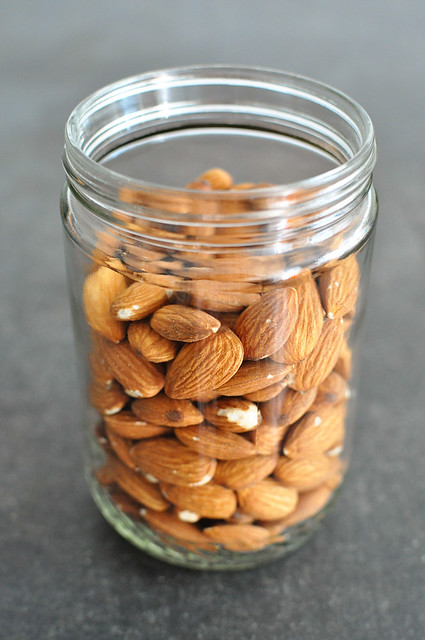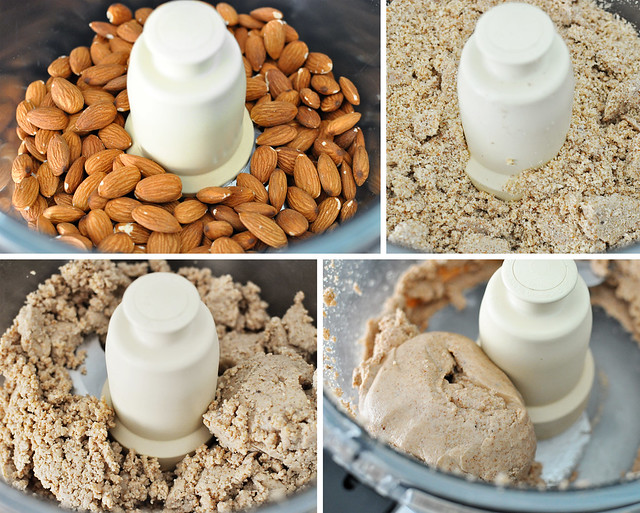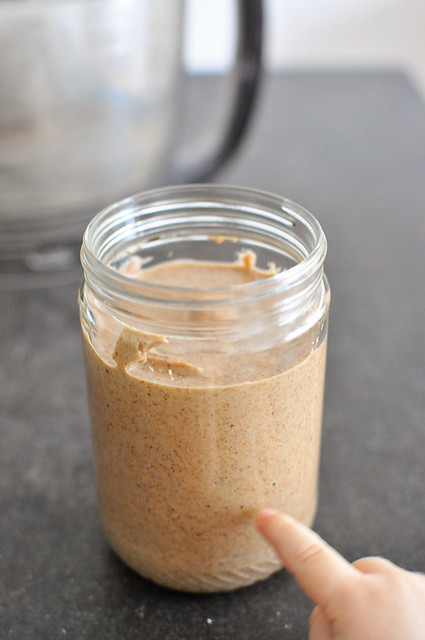
I may not be reinventing the wheel with this one, but it’s a staple around here and a method that merits mentioning—even though I’m decidedly not the first to do so. If you haven’t seen this party trick yet (or just haven’t gotten around to trying it out), get ready to save some money and impress all your friends, all while barely lifting a finger.
Homemade almond butter, people. Toss some almonds into a food processor, turn it on, let it run until you have almond butter. End of story. Goodnight!
It really is that simple, but let’s talk a little more about why you might want to make your own and all the wonderful ways that you can use this pantry staple.
We really love raw almond butter in this household. Unlike loud, toasty peanut butter, raw almond butter is mellow and sweet. It can take a few tries for some people to get used to the taste (I’ve heard it compared to anything from wallpaper paste to raw dough, which I believe, having thought similarly myself at one time, says more about what people’s taste buds are accustomed to than it does about the almond butter itself, but I digress….), but for those who enjoy it straight up, it makes a great spread for toast, crackers, or sandwiches. Roman will eat it off his toast by the fistful and beg for another schmear before even considering the bread.
Raw almond butter can also work as a whole-food-based fat source in baking—as opposed to things like oils and vegan margarine, which are refined. It’s not a one-to-one substitution, but if you know how to build a recipe, it can be a great addition to the ingredient list. Because it has such a mild flavor, almond butter disappears seamlessly into cookies or muffins while still lending moisture, fiber, and all those awesome nutty nutrients.
I also like to keep raw almond butter around because we don’t usually keep plant milk on hand. We simply don’t use it very often, and I found that the last few times I bought a quart, I wound up having to dump a fair amount down the sink. When I’m making a recipe that definitely needs a “milk,” I find that it’s easy enough to whip up an appropriate amount of either cashew or hemp milk, but I wouldn’t keep these handy either since they have an even shorter shelf life than the storebought stuff. All that to say: in things like smoothies, oatmeal, or even raw chia-based cereals where you might want to add some creamy richness via plant milk, you can achieve a similar effect by using water as a base and dropping in a spoonful of raw almond butter. I even like to add a dollop to Roman’s homemade soy yogurt in the mornings because a) he loves it and b) for a little nutrient diversification.
So there’s the what. Now the why.
Almond butter is expensive. Raw almond butter is even more expensive. And organic raw almond butter is laugh-out-loud, holy-crap-this-sticker-must-be-wrong-but-OMG-it’s-not expensive. Raw almond butter will run you anywhere from $12-14 for a 16-ounce jar, and organic raw almond butter costs upwards of $20 for the same amount. Ouchie ouch ouch.
Since we go through a jar that size every two weeks or so, and since I try to make sure that things are organic as much as possible around here, we needed to find a better way. So, I did some price-comparing, purchased some organic almonds in bulk, and started making my own butter. This brought my cost per jar down by more than half. Definitely a win.
Plus, now I get to brag that I make my own almond butter, which adds to my crunchy persona and sounds labor-intensive, but really just means that I turn the food processor on and go do something else for about 10-15 minutes. Then I give Roman a fingerful straight from the bowl, because, seriously, that kid loves this stuff.
Pro-tip: When buying nuts and seeds in bulk, store them in the fridge or freezer for a longer shelf life.
This method couldn't be more simple and can save you a lot of money. I recommend using an old, clean nut butter jar to store your finished almond butter, but any jar will work--just make sure it has a fairly wide mouth so you can get your butter out. If you don't have a 16-oz jar, measure your almonds by filling the jar you do have about ¾ of the way full twice; this should give you one full jar of almond butter.
- 16 ounces (about 3 dry cups) raw almonds
- Place your almonds in the bowl of a food processor fitted with the S-blade. Turn on the processor.
- As the processor runs, the almonds will form a meal, become sticky and crumbly, and then will form a large ball. This may cause your food processor to rattle a bit. Eventually the ball will break down and smooth out. The almond butter is finished when it is completely smooth and flows freely in the processor. Depending on your machine, this will take anywhere from 10-15 minutes from start to finish. Scrape down the bowl along the way as needed.
- Transfer your almond butter to a clean jar and store in the cupboard. Stir before each use. As with any natural nut butter, separation over time is normal.




oh I just home made nut butters! absolutely yummy!